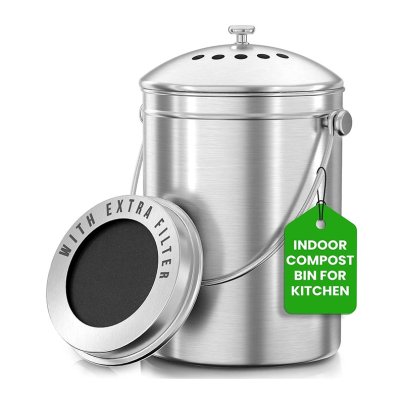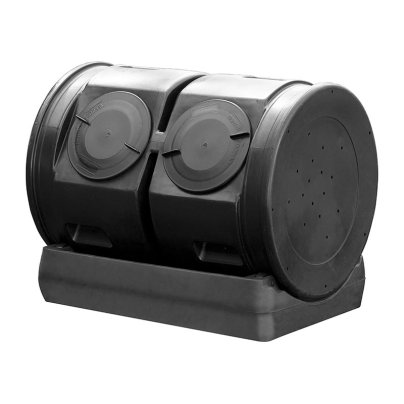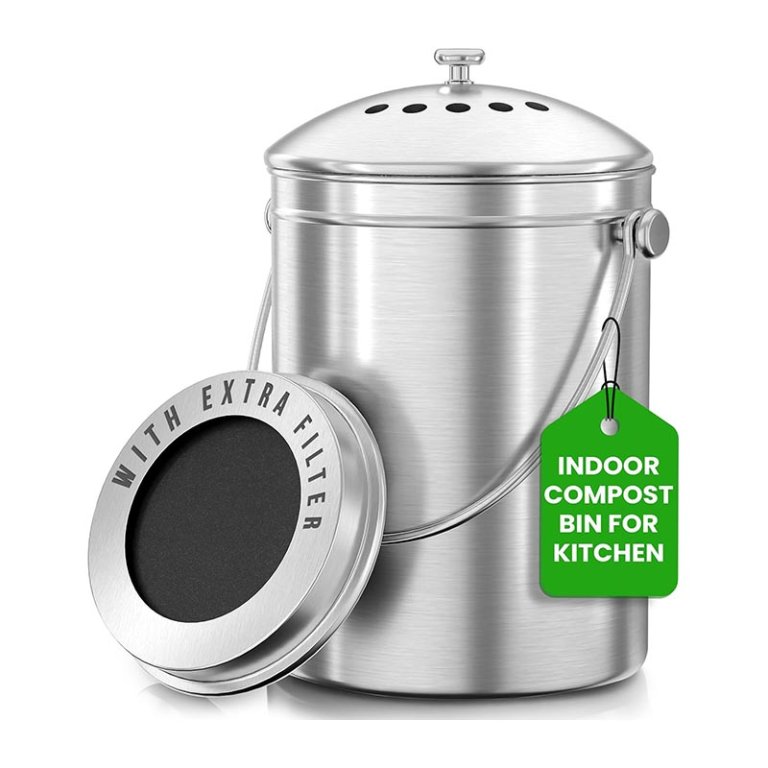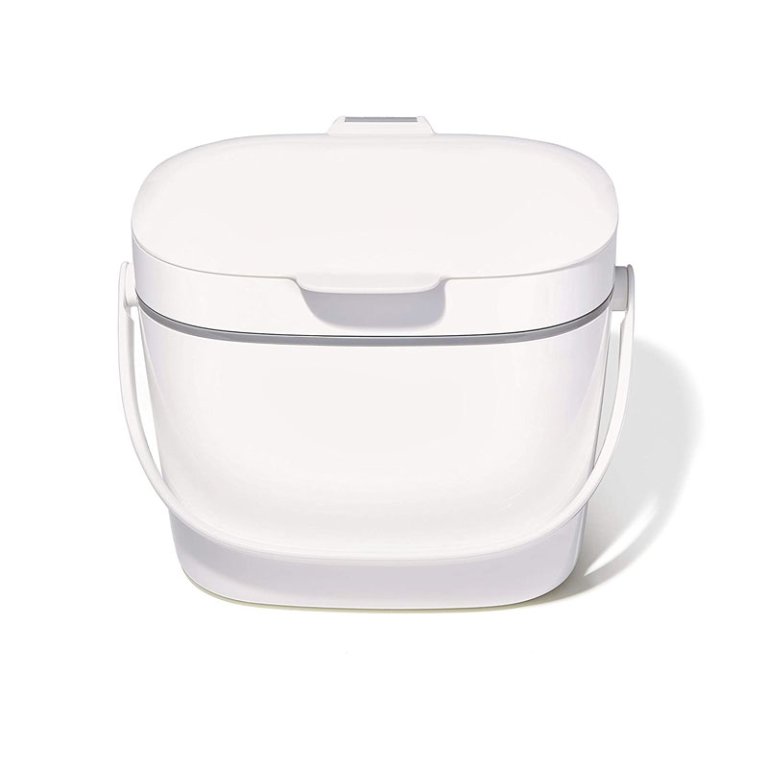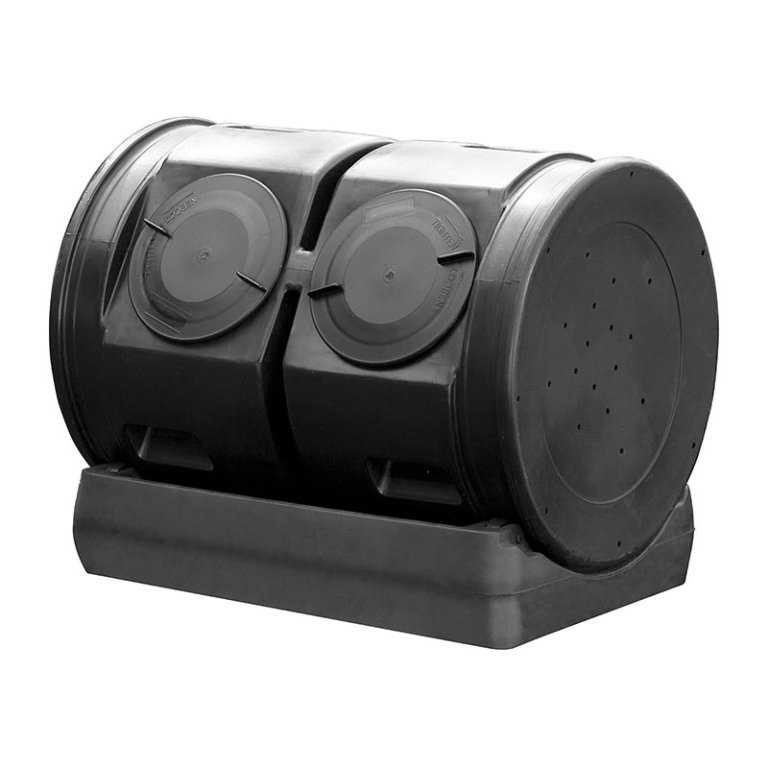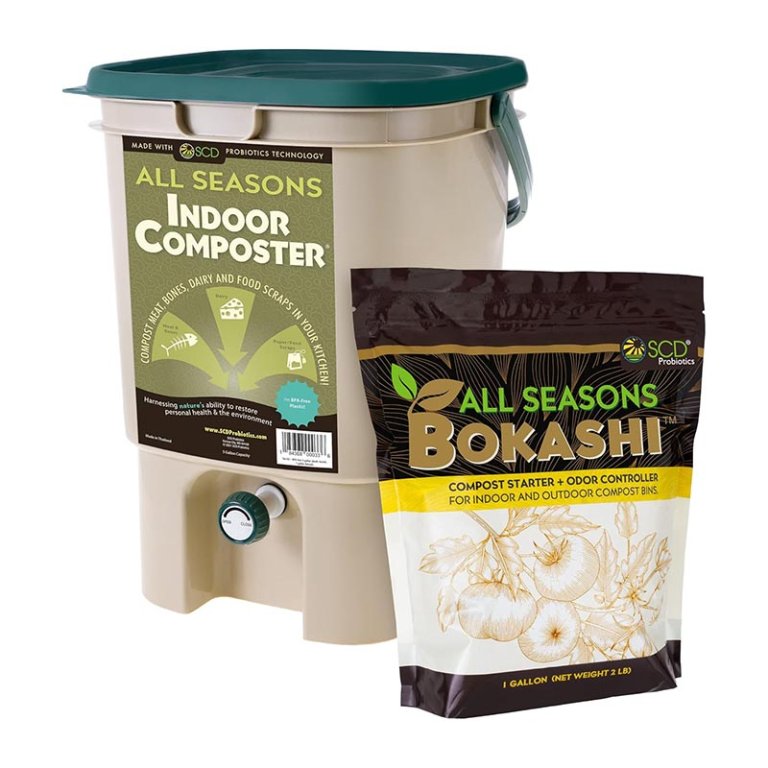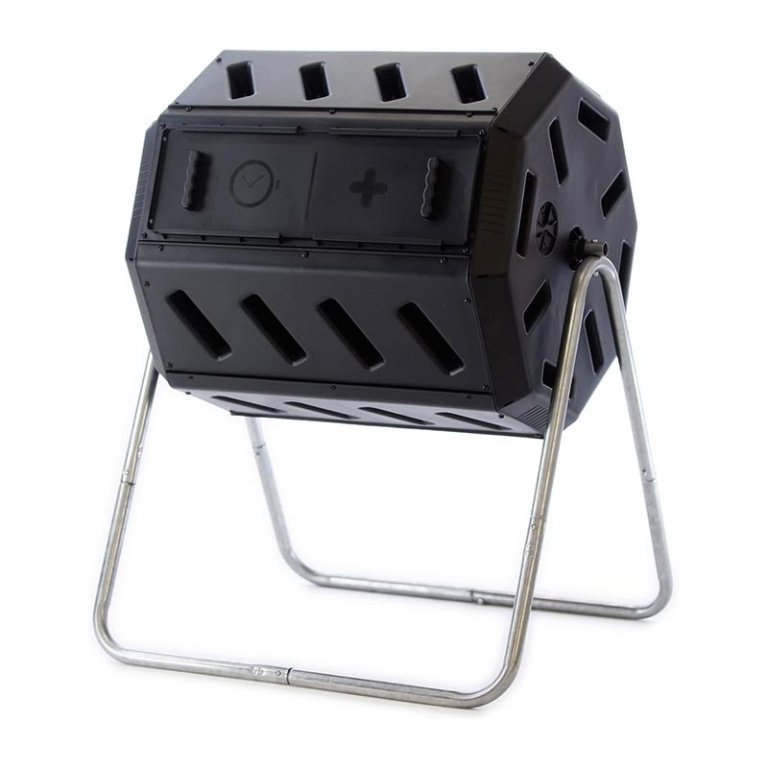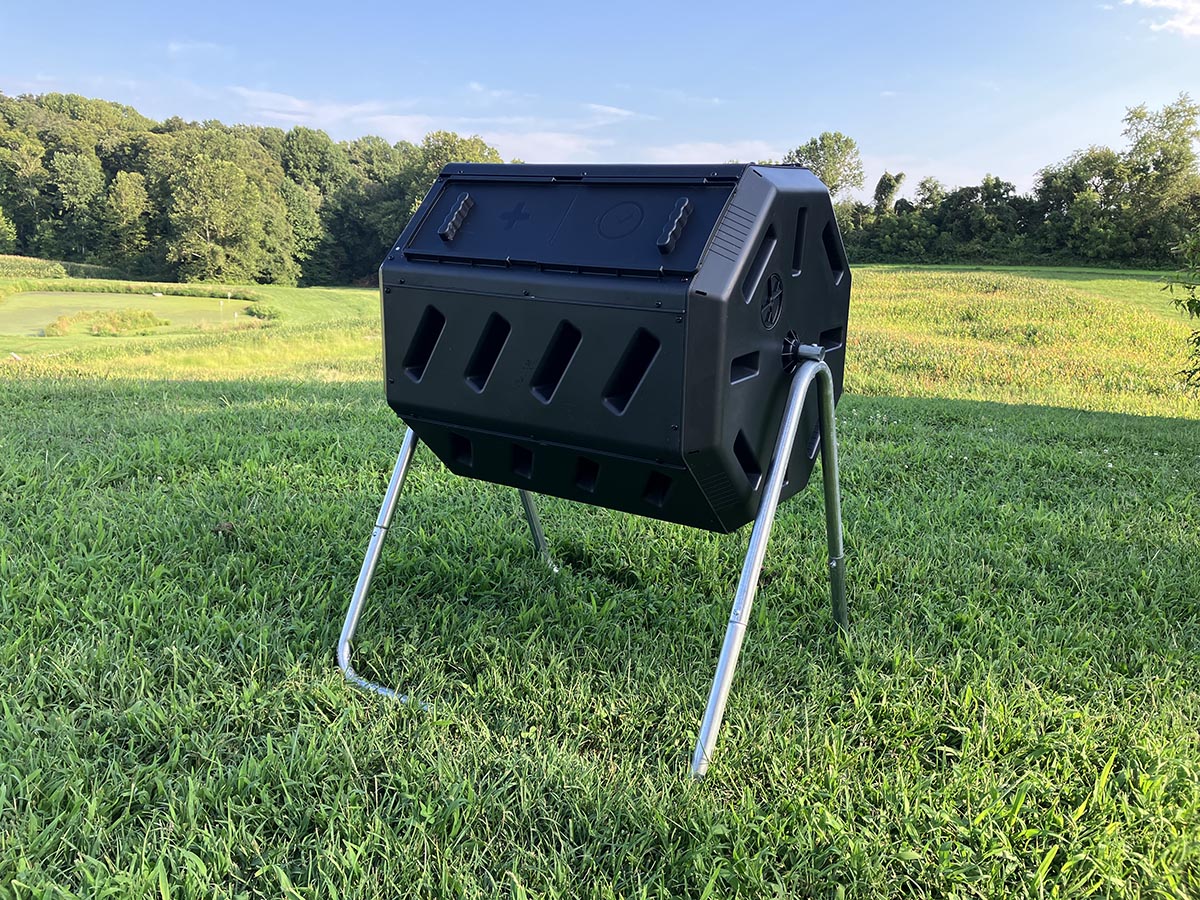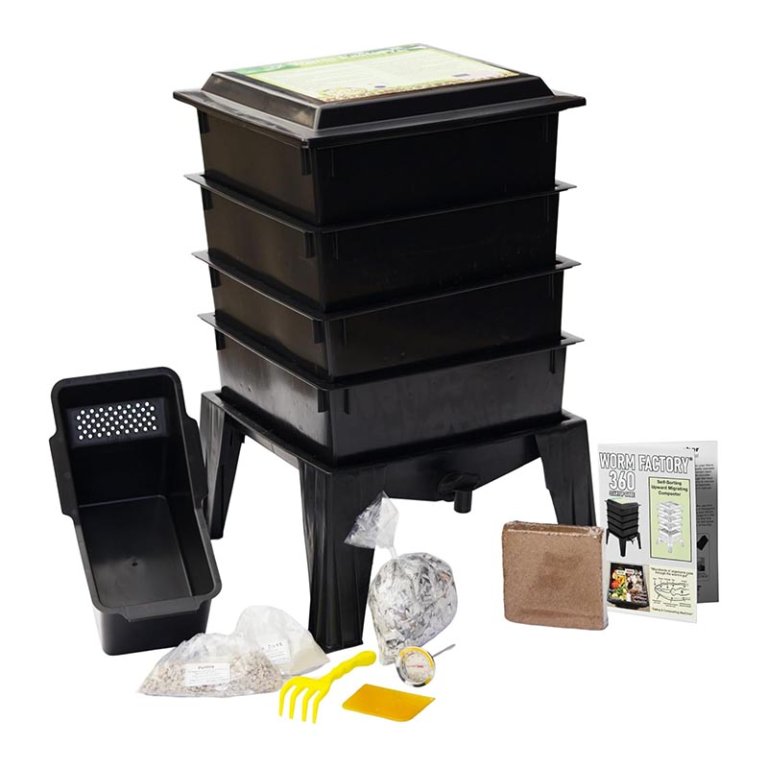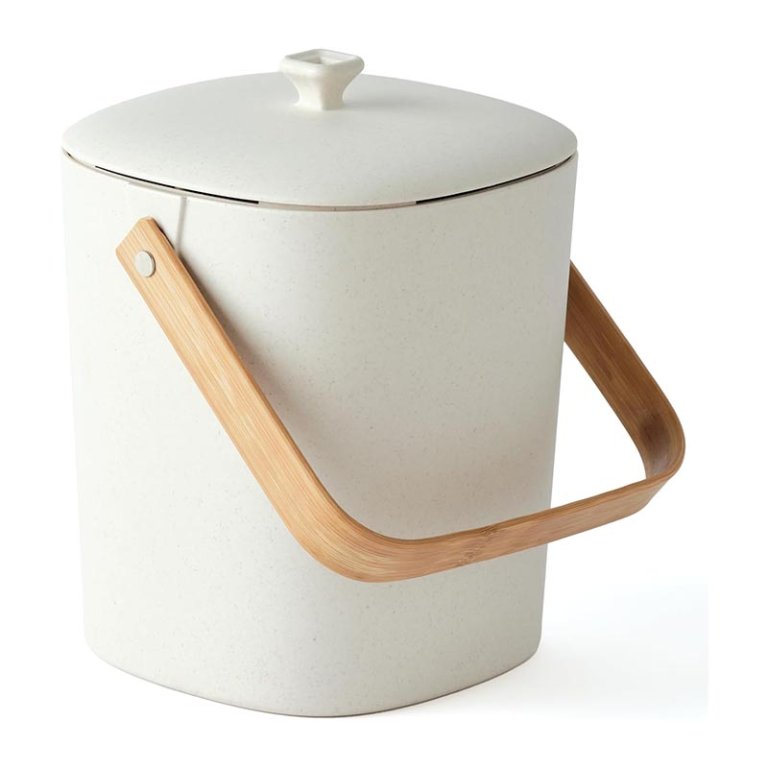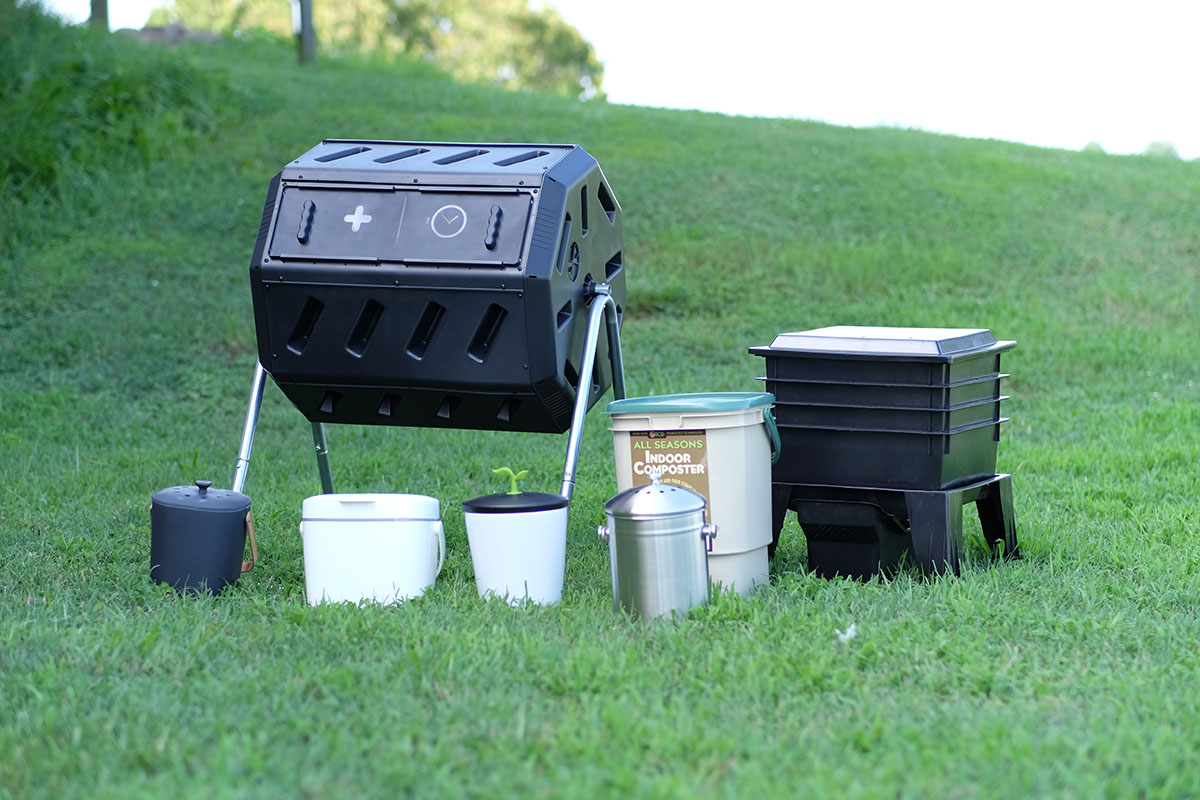
We may earn revenue from the products available on this page and participate in affiliate programs. Learn More ›
Compost is like a multivitamin for your soil, and compost bins are the secret to transforming everyday organic material into gardening gold. Made of thoroughly decayed organic material used as a fertilizer, compost encourages healthy plant growth, strong roots, and bountiful blooms and fruit. A neat, easy alternative to an open compost pile in your yard, a compost bin creates compost faster than traditional piles by regulating the temperature, moisture, oxygen, and bacteria in the organic materials to help them break down faster.
The DIY approach also beats buying bags of compost at a garden center, which can cost from $5 to $20 per bag, depending on the size. Plus, creating compost is not just good for your garden, it’s also great for the planet. According to the Environmental Protection Agency, food scraps and yard waste make up more than 28 percent of what ends up in landfills.
Compost bins come in a variety of shapes and sizes; the best one for you depends on how much organic waste you produce, the amount of space you have, and how you plan to use the finished product.
To help you better assess all the compost bins out there, we tested some of the top-rated products for both indoors and out. After testing, our favorite was the Utopia Kitchen Compost Bin for its durable construction and compact size, but we found a lot to like about several bins. Keep reading to understand how to zero in on your ideal compost bin—and find out why the following made our list of the best compost bins.
- BEST OVERALL: Utopia Kitchen Compost Bin
↓ Jump to Review - BEST BANG FOR THE BUCK: OXO Good Grips Easy-Clean Compost Bin
↓ Jump to Review - BEST COMPOST TEA: Good Ideas 50-Gallon Wizard Compost Tumbler Kit
↓ Jump to Review - MOST DURABLE: FCMP Outdoor IM4000 Tumbling Composter
↓ Jump to Review - BEST SERIOUS INDOOR USE: SCD Probiotics All Seasons Indoor Composter
↓ Jump to Review - BEST FOR URBAN GARDENERS: Worm Factory 360 Composting System
↓ Jump to Review - MOST ECO-FRIENDLY: Bamboozle Food Compost Bin
↓ Jump to Review
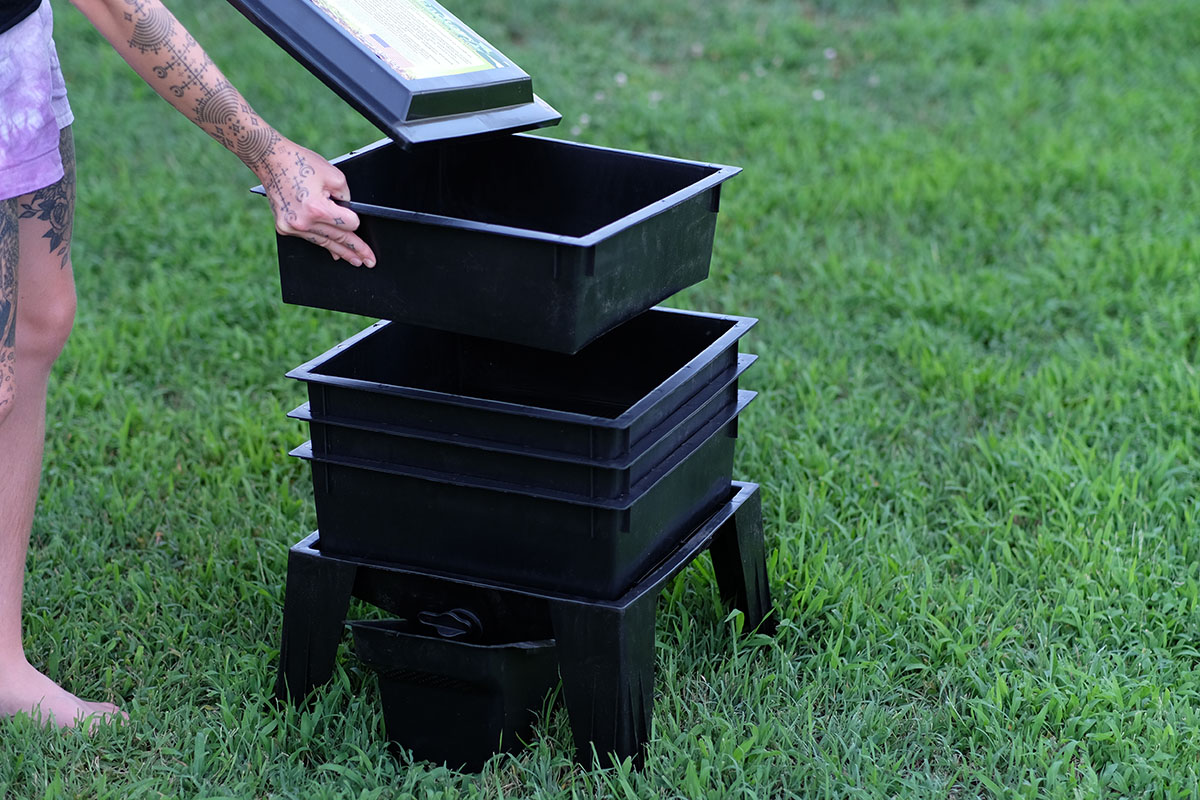
Our Top Picks
The following compost bins are our top picks for specific home and garden uses, based on design, cost, and customer satisfaction.
Best Overall
Utopia Kitchen Compost Bin
Buy at AmazonWhat We Like
- Versatile size can fit almost anywhere
- Silver finish looks great with a variety of decor styles
- Can be used with or without liner
- Comes with an extra carbon filter to limit foul odors
What We Don’t Like
- Removing lid to add waste can get cumbersome
- When bin is full, compost can stick to lid
Specs
- Material: Stainless steel
- Capacity: 1.3 gallons
- Weight: 2 pounds
Our Ratings: Assembly 5/5; Ease of Use 4.5/5; Build Quality 4.7/5; Value 5/5
The attractive 1.3-gallon Utopia Kitchen Compost Bin technically doesn’t make compost; it simply holds kitchen waste until you take it to an outdoor compost tumbler or worm bin. For optimal longevity and durability, it’s made of high-quality grade 201 stainless steel that won’t scratch, crack, or chip. The bin also comes with charcoal filters that trap odors, so food scraps can build up during the week without attracting pests or releasing bad smells into your home.
During testing, this compost bin was easy to open and empty, easy to clean, and surprisingly lightweight, even when filled with compost. It’s attractive enough to display on the kitchen counter, but can also be hidden under a cabinet. The bin comes with a replacement filter so you can swap out your old one when it’s time. We tested the bin both with a liner and without, and it worked great both ways, although using liners (compost bags) helped minimize mess and the need for cleaning.
Get the Utopia Kitchen compost bin on Amazon.
Best Bang for the Buck
Photo: AmazonWhat We Like
- Size is ample enough for large amounts of compost
- Removable, flip-open lid is easy to open and use
- Has a mechanism on the back to keep compost bags in place
- Bin is lightweight and easy to move, even when full
What We Don’t Like
- Entire unit is plastic
- Does not control odor
Specs
- Material: Plastic
- Capacity: 1.75 gallons
- Weight: 1.6 pounds
Our Ratings: Assembly 5/5; Ease of Use 5/5; Build Quality 4/5; Value 4.5/5
For storing under the kitchen sink or on the countertop, the small but sturdy OXO Good Grips compost bin holds up to 1.75 gallons of compost and is designed to be used with a liner (also called compost bags). Unlike other bins, this bin has a mechanism in the back that secures the bag and helps prevent the liner from sinking down as you fill the bin with scraps.
During testing, it was obvious that this feature made this bin stand out from other indoor compost bins. Unlike other bins, the lid opens very easily, and it has an oversized latch. The entire lid part is removable to make emptying the bin and cleaning it easier. The sturdy handle made moving the bin easy, even when filled with compost, and with the oversize square shape, it was easy to add scraps but not difficult to store the bin.
Get the OXO Good Grips compost bin at Amazon, Wayfair, or Macy’s.
Best Compost Tea
Good Ideas 50-Gallon Wizard Compost Tumbler Kit
Buy at AmazonWhat We Like
- Integrated compost tea base
- Fully assembled out of the box
- Twist-off lids fit snugly
- Durable outdoor compost bin
What We Don’t Like
- Can be challenging to tumble when full
Specs
- Material: BPA plastic
- Capacity: 50 gallons
- Weight: 28 pounds
Our Ratings: Assembly 5/5; Ease of Use 4.5/5; Build Quality 4.5/5; Value 4.8/5
Thanks to its wheeled, built-in tea-collecting base, the Good Ideas compost tumbler pulls double duty. The body is made from tough, FDA-approved recycled plastic, and ours arrived fully assembled—no setup required, which was a pleasant surprise.
The twist-off lids seal tightly, supporting the manufacturer’s claim that the unit is pet- and rodent-proof. From the start, we found this model both sturdy and user-friendly. Its low profile keeps it stable, even in strong winds, and the barrel manages to be compact while still offering plenty of space. It’s perfect for busy gardeners who want a steady supply of compost.
The trade-off is that its generous capacity makes the tumbler heavy once filled, so rotating it takes some effort. Still, the durability and built-in compost tea collection make this a long-lasting option that’s tough to beat.
What our tester said: “The Good Ideas compost tumbler really impressed me—not only is it pest-proof and made from high-quality materials, it also produces compost tea for fertilizing my plants.” ~ Glenda Taylor, Product Reviews tester and writer
Best Serious Indoor Use
Photo: AmazonWhat We Like
- Large size can accommodate ample amounts of compost
- Makes and dispenses useful compost tea
- Can compost meat, bones, and dairy waste
What We Don’t Like
- Material must be added regularly to accelerate composting
- Lid cumbersome to remove
Specs
- Material: Recycled plastic
- Capacity: 5 gallons
- Weight: Not listed
Our Ratings: Assembly 5/5; Ease of Use 4.5/5; Build Quality 4.5/5; Value 4.5/5
If you don’t have room for a full-size composter or prefer to compost indoors, the SCD Probiotics All Seasons Indoor Composter will fit right under your sink and won’t stink up the kitchen. The SCD is an anaerobic composter, meaning it uses microorganisms that do not require oxygen to break down food scraps. This bin relies on inoculated bokashi bran to “pre-ferment” food scraps (including small bones, meat, dairy, and oily foods), thereby accelerating the composting process.
The process doesn’t fully “cook” kitchen scraps into traditional compost, so you’ll need to bury or scatter the contents in an outdoor garden to finish the process. The 5-gallon airtight bucket has a handy spigot for releasing compost tea—a potent liquid fertilizer—as food scraps ferment. The compost tea is strong, so be sure to dilute it with water before fertilizing houseplants or outdoor containers.
There were many things to love about this compost bin while testing. The large size cut down on the emptying of the bin, and yet it could fit under the sink or near a trash bin. It also composted the material directly in the bin. Although the lid was cumbersome to remove and secure each time we deposited food scraps, the size of the bin made up for the inconvenience. The spigot for compost tea was also extremely handy and made it easy and efficient to water and feed indoor or outdoor plants.
Get the SCD Probiotics compost bin on Amazon or SCD Probiotics.
Most Durable
Photo: AmazonWhat We Like
- Durable enough to resist damage and minor abrasions
- Provides instructions for proper composting
- Makes it easy to rotate compost
- Large enough for bigger gardens and outdoor spaces
What We Don’t Like
- Instructions are not clear
- Bulky and difficult to move when full
- Plastic material has an odor
Specs
- Material: Plastic and metal
- Capacity: 37 gallons
- Weight: 28 pounds
Our Ratings: Assemly 2.5/5; Ease of Use 4.5/5; Build Quality 4.3/5; Value 4.3/5
If you need a consistent supply of fresh compost to feed your flowers and vegetable garden, then the FCMP Outdoor IM4000 Tumbling Composter will fit the bill. At 37 gallons, it holds plenty of kitchen scraps, grass clippings, and other yard and garden waste—yet despite its ample size, this tumbler is easy to turn. It also features double inner bins, which allow you to have two batches of compost in different stages of decomposition going at the same time.
Give the barrel five to six spins every 2 or 3 days to aerate the compost. As long as the mixture balance is correct, the FCMP tumbling composter will create ready-to-use compost in as little as 2 weeks.
This compost bin was difficult to assemble and came with no written instructions, so we had to rely on graphics and trial and error to assemble the bin, which took about an hour for two people. Required tools were not included with the product. Once assembled, however, the bin was easy to use and rotate, even when it was filled with compost.
Although its size can attract attention in the yard, it can also be placed conveniently by the garden so that when the time comes to deposit the compost, you don’t have far to move it. The bin comes with vents on the side, which can be closed to “cook” the compost and opened to allow ventilation.
Get the FCMP Outdoor compost bin at Amazon, Target, or Lowe’s.
Best for Urban Gardeners
Photo: AmazonWhat We Like
- Easy to assemble construction
- Can hold various stages of compost
- Has tea collector tray and watering “can”
What We Don’t Like
- Have to remove trays to use compost
- Does not come with necessary worms
Specs
- Material: Plastic
- Capacity: Varies depending on number of trays
- Weight: Varies depending on number of trays
Our Ratings: Assembly 5/5; Ease of Use 4/5; Build Quality 4/5; Value 5/5
Worm compost bins are perfect for city gardeners whose spaces are limited. A sunny windowsill or kitchen corner is the perfect spot for the Worm Factory 360. At less than 2 feet tall and wide, the composting bin won’t take up much space. The basic model features four stacking trays, but you can add more to handle additional compost materials if needed.
The kit does not supply red wiggler worms (you’ll need to purchase them separately), but will advise on how many pounds of worms to buy. It does, however, come with a few handy accessories, including mineral rock dust for nutrients, a thermometer, a hand rake, a scraper, worm ladders (which help them move up through the compost), and worm bedding. Best of all, there’s very little assembly involved—just unpack and stack.
This compost bin was extremely easy to assemble and left no questions about where to put parts. The stacking trays allowed for different stages of compost to develop at the same time and made it easy to empty the compost into the garden. The handy spigot for compost tea was an extra bonus. The size falls between a large and small composter, making it ideal for those with smaller backyards who are still serious about composting.
Get the Worm Factory compost bin on Amazon or Worm Composting Headquarters.
Most Eco-Friendly
Photo: AmazonWhat We Like
- Available in a variety of colors
- Controls odors
- Dishwasher-safe design
- Unique square design
What We Don’t Like
- On the smaller side
- Lid is heavy
- Some users noted that the bin is breakable
Specs
- Material: Bamboo
- Capacity: 1 gallon
- Weight:
Our Ratings: Assemly 5/5; Ease of Use 5/5; Build Quality 4/5; Value 4/5
The Bamboozle Food Composter comes with extra charcoal filters to replace the existing one in the lid for odor control. It can sit on the counter or under the sink and holds approximately 1 gallon of scraps. The square shape is unique compared to many other countertop compost bins, and its neutral colors (charcoal or natural) blend in well with a variety of decor to be discreet on a countertop.
While testing this product, we noticed the lid had a bit of weight to it that became cumbersome to keep lifting whenever we added waste to the bin. We tested the bin with and without a liner. While the liner made it easier to clean and use, the bin could just as easily be used without a liner. According to some users, this bin is breakable, which makes using it with a liner preferable to minimize the need to move the bucket so often when emptying compost: Just pull out the liner bag.
Get the Bamboozle compost bin at Amazon, Wayfair, Tractor Supply Co., or Crate & Barrel.
ALSO TESTED
While the Chef’n EcoCrock Counter Compost Bin looks stylish and controls odor, we didn’t rate it quite as highly as other products. Even for a small kitchen, we found that the inner plastic bucket is too small and fills quickly, creating frequent messes on all components and the need for extra cleaning.
Jump to Our Top Picks
How We Tested the Best Compost Bins
Each product was tested based on how easy it was to assemble, use, and clean. Using a rubric, we tested specifically for durability, how easy it was to empty and fill each compost bin, and how well any mechanisms worked, such as vents, filters, and spigots for compost tea. We also tested for odor control as well as the value of each bin for the price.
In the end, each bin was compared against the others based on its ease of use—this included assembly as well as daily use of the product. We also evaluated the durability and eco-friendliness of the materials and the capacity of the compost bins and compared features, usability, and price to determine the best products.
What to Consider When Choosing a Compost Bin
Conventional vs. Worm Composting
Before you choose a compost bin, you’ll need to decide if you want to use the conventional composting method or vermicomposting (worm composting). Both methods will produce rich compost for your garden, but the method you choose depends on your available space and lifestyle.
- Conventional composting involves mixing organic waste in an optimum ratio of 30 parts carbon to 1 part nitrogen in the presence of moisture and air. High carbon ingredients, or “browns,” include shredded newspaper, coffee grounds, and dead leaves. Vegetable scraps, grass clippings, and weeds fall into the high nitrogen “greens” category. In a warm, moist, aerated mixture of browns and greens, microbes like bacteria, actinomycetes, fungi, and others decompose the mixture into a finished soil amendment.
- Worm composting employs red wiggler worms to consume organic waste and produce compost in the form of “castings” (worm manure). This produces a super-rich, fertile compost loaded with nitrogen, phosphorus, potassium, and many micronutrients. The worms keep the compost aerated and tumbled, so there’s no work required other than feeding them kitchen scraps and providing paper bedding. The most common worm composting systems are small bins that fit in a corner of the kitchen or in the garage (don’t worry, it won’t smell if tended to properly), but larger bins are available if you’re looking to produce a lot of compost. Worm composting bins need to be kept between 40 and 80 degrees Fahrenheit (worms don’t like it too cold or hot), so keep the bin in a sheltered area.
Capacity
Bigger isn’t necessarily better when it comes to compost bins. In general, small bins run from 1 to 10 gallons, medium bins hold 11 to 30 gallons, and large bins are at 31 gallons or more. A small bin probably won’t be enough to maintain a large amount of yard debris. Compost needs to be turned—for aeration and distribution of materials—and that can be more challenging in a larger bin. Plus, the larger the bin, the longer the pile has to keep “cooking” to turn into compost.
Stationary vs. Tumbling
There are two main types of compost bins: stationary and tumbling.
- Stationary bins have a larger capacity than tumblers and are a good choice for those who have a lot of yard waste such as weeds, leaves, and grass clippings. To keep the compost pile cooking, you will need to manually turn it with a pitchfork every once in a while.
- Tumbling composters are sealed containers that can be rotated to mix the composting materials. They are elevated on a stand and typically have a handle, which makes turning the contents a quick and effortless job. Though smaller than stationary bins, tumbling bins are popular for their efficient design, which helps decomposition occur very quickly.
The type of bin you choose will depend on how much work you want to do, how much organic material you have, and how fast you want to create compost. If you have a lot of yard debris and you don’t mind manually turning the compost pile every once in a while, then a stationary bin will work. If you need compost fast and don’t want to bother with a pitchfork, a compost tumbler is probably your better bet.
Material
Most compost bins are made out of plastic, wood, or metal, and most commercially available composters are manufactured from dark-colored recycled plastic. Dark plastic bins are ideal for absorbing heat from the sun and preventing moisture loss. DIY compost bins are commonly made of wood, metal, or stone. Keep in mind that bins used outdoors should be made from weather-resistant materials that will fit aesthetically with your landscape.
Shape
Compost bins are cylindrical, rectangular, square, or pyramid-shaped. In most cases, bin shape will be determined by the style of composter you intend to purchase and what fits best in your yard. If you’re tight on space, square/rectangular bins fit snugly into corners.
Odor Control
A properly mixed compost pile will have very little odor. Maintaining a balance of high-carbon brown and high-nitrogen green materials, aeration, moisture, and temperature will prevent the compost from producing odor. A properly made compost bin should have air vents or holes on selected parts of the bin for proper ventilation. Some bins have charcoal filters to help mitigate odor.
Location
Stationary outdoor compost bins can go either in the shade or sun, depending on how fast you want the composting process to go. The sun helps increase the temperature, so the bacteria and fungi work faster. Tumblers or smaller bins can be moved to any part of your yard or home as needed.
FAQs
Learning how to compost can take time, but with the right bin and strategy, you’ll be on your way to having fertile garden soil in no time.
There is such a thing as turning your compost too often. Ideally, you should rotate your compost pile or bin every 2 weeks to accelerate the composting process.
Compost is ready to use when there are no visible scraps in it—it should look like dark soil.
Simply dilute the tea after it comes directly from your compost pile, and water indoor or outdoor plants with it.
Meet the Testers
As a freelance writer, Jenn covers many different topics, including green buildings, natural and sustainable skin care products, natural health remedies, and disease prevention—and she absolutely loves learning about new things through her work. When she has free time, she enjoys writing about her personal growth and health on her blog at thegreenwritingdesk.com.
Glenda Taylor is a product tester and writer specializing in the construction, remodeling, and real estate industries. She and her husband own a general contracting company, and Taylor is experienced in both residential and commercial building applications. She tests a wide range of power tools as well as other home improvement, household, and lawn-and-garden products.
Additional research provided by Debbie Wolfe.
